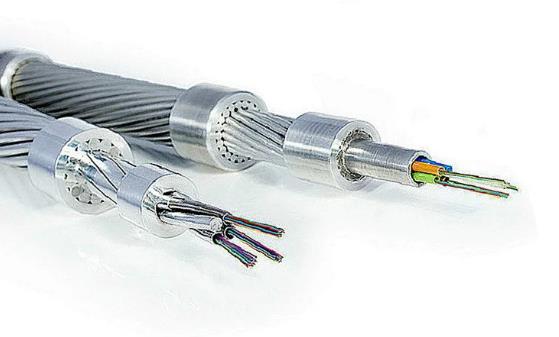OPGW structure
OPGW cable is a composite ground wire that combines lightning protection and communication functions with Optical fiber placed in the overhead ground wire, so it is called Optical fiber composite overhead ground wires (OPGW or OPGW cable for short). OPGW cable has the dual function of traditional overhead ground wire and optical fiber communication capability. The basic structure of OPGW consists of a cable core with optical fiber (optical unit) and stranded metal wire (aluminum clad steel wire ACS or aluminum alloy wire AA). The optical fiber provides the transmission channel, the steel component mainly provides the mechanical strength, and the aluminum component mainly carries the short-circuit current. The outer layer of OPGW is aluminum clad steel or aluminum alloy wire, which requires that the diameter of a single strand is not less than 3.0mm to reduce the breakage of the strand by lightning. OPGW the outermost stranding is right-handed.
In addition, according to the structure of the optical unit, OPGW is divided into lamination, center beam tube, single tube, double tube and so on.

OPGW classification
Generally, there are two types of loose sleeve and tight sleeve.
Loose sleeve: loose sleeve type is to put the optical fiber into the loose tube full of oil paste to form a certain length of the remaining length, the remaining length is generally controlled in about 0.7% of the total length of the cable, the fiber to its own length to meet the initial elongation of the ground wire and the deformation generated in the operation process, to ensure that the optical fiber in the cable is not stressed, but the structure is loose.
Tight-fitting type: On the basis of the fiber can be stressed, in order to meet the requirements of fiber stress, the external force corresponding to about 1% elongation is applied to the fiber in the production for screening, that is, the "prestressed" is applied to the fiber. The fiber that has been screened has a tensile strength higher than that of the outer strand and can be broken behind the outer strand.
Due to the above design differences, when the metal cross section and destructive power are the same, the design safety factor of the loose sleeve structure is 70% ~ 75% of the tight sleeve structure. Due to the characteristics of the structure, the price of loose cover type is low, suitable for light external load conditions, terrain changes are not drastic lines; The price of the tight type is more expensive, suitable for the external load condition is worse, the terrain change is larger and the ground force is more complex line. Therefore, in the design of the choice of optical cable type, can not simply put two different structure of OPGW optical cable on the same level, should be based on its specific strengths and weaknesses, combined with the specific conditions and performance price ratio to select the structure.
For the transmission line in non-heavy ice area, OPGW with loose set stainless steel tube layer is suitable. The structure type of OPGW of transmission line in heavy ice area should be determined by technical and economic comparison according to the ice-covered condition of the line. In the loose and tight type can meet the requirements of the line, to choose the loose type is appropriate. In heavy ice area, it is appropriate to choose tight - covering type.
OPGW the same layer of stranded wire should be selected from the same material, and the outer monofilament should be aluminum clad steel monofilament, diameter should not be less than 3.0mm.
03-21
202502-12
202509-12
202409-05
202408-16
202408-07
202408-06
202408-02
202407-30
202407-29
2024
